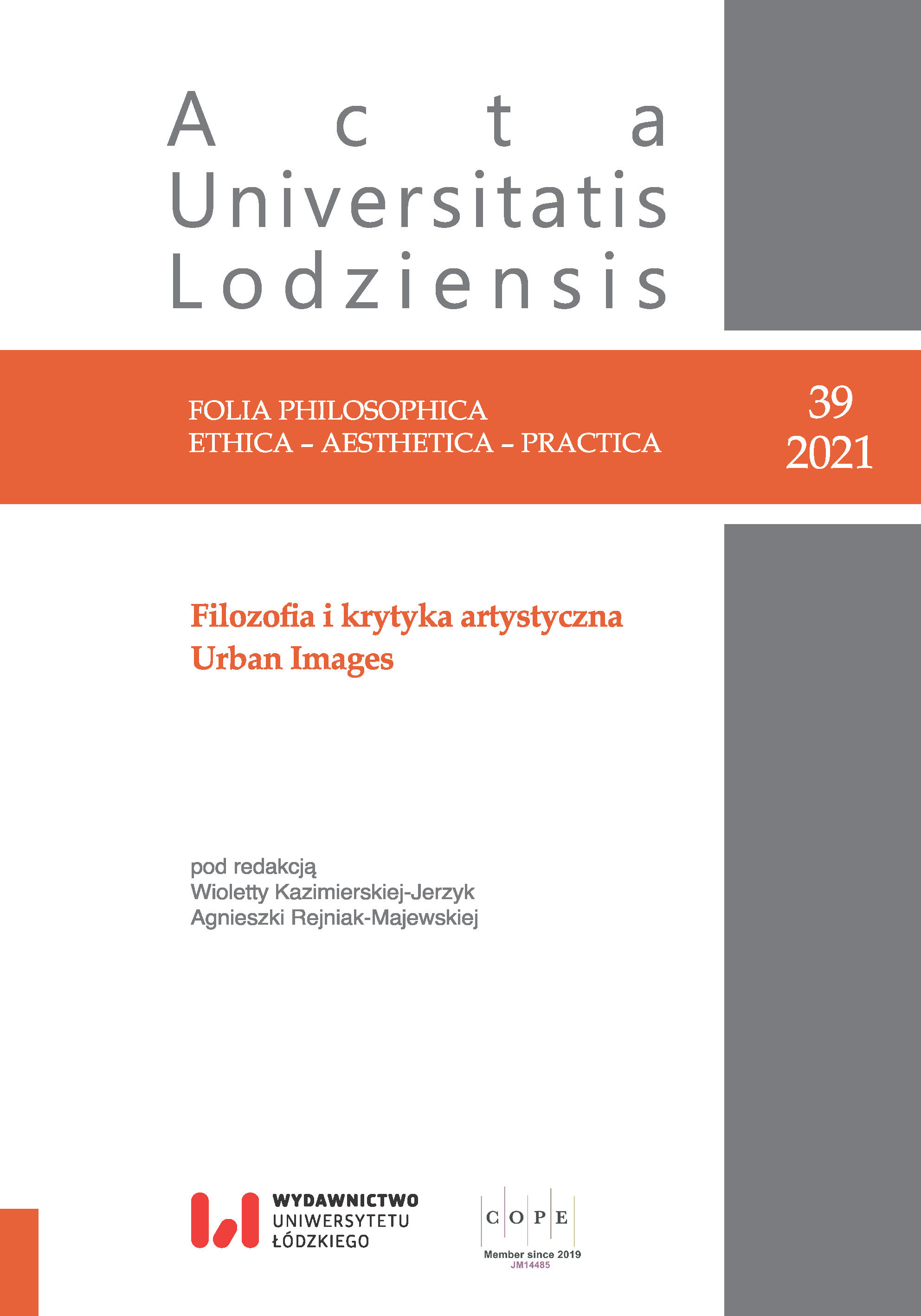On the notion of the primitive, folk art and children’s art in the writings of Stefan Szuman
DOI:
https://doi.org/10.18778/0208-6107.39.02Keywords:
primitive art, children’s art, folk art, Stefan Szuman, personalistic pedagogyAbstract
The article is devoted to the aesthetic concepts of the Polish philosopher and pedagogical theorist, Stefan Szuman (1898-1972). Szuman’s interest in the work of children and folk art was in line with the shift towards the “primitive” in European culture at the beginning of the 20th century, which resulted from the critical assessment of the processes of modernization and longings for regeneration, as well as from the anthropological research on the structure of primitive societies and their creativity. Like Franz Boas, who in his theory of primitive art rejected the evolutionist model and the identification of “primitive” with a lower stage of development, Szuman emphasized the specificity of children’s creativity and folk art. Referring to the neo-evolutionist ethnologist Max Richard Verworn (the concept of “ideoplastic”) and to the psychological hypotheses od Jean Piaget, Szuman saw in the art of children a connection with the organic development of cognitive abilities and the need to externalize them. The concept of education through art proposed by Szuman, which assumed not so much a ready curriculum as supporting the development of students, has become a part of the trend of personalistic pedagogy, represented in Poland among others by Henryk Rowid, Janusz Korczak and Antoni Kenar.
References
Antliff, M. i Leighten, P. (2003). Primitive. W: Nelson, R. i Shiff, R. (red.), Critical Terms for Art History. Chicago: Chicago University Press, s. 217–233.
Google Scholar
Bartkowiak, E. (2012). Uczeń (dziecko) w pedagogice personalistycznej okresu Drugiej Rzeczypospolitej. W: Dormus, K. i Ślęczka, R. (red.), W kręgu dawnych i współczesnych teorii wychowania. Uczeń – szkoła – nauczyciel. Kraków: Uniwersytet Pedagogiczny w Krakowie, ss. 91–108.
Google Scholar
Boas, F. (1951). Primitive Art. New York: Capitol Publishing Co.
Google Scholar
Engels, F. (1884). Der Ursprung der Familie, des Privateigentums und des Staats. Anschluss an Lewis H. Morgans Forschungen. Hottingen–Zürich: Verlag der Schweizerischen Volksbuch-handlung.
Google Scholar
Flam, J. i Deutch, M. (red.) (2003). Primitivism and Twentieth Century Art. A Documentary History. Berkeley and Los Angeles: University of California Press.
Google Scholar
Gomóła, A. (2014). Na początku był zachwyt. Młody Krzywicki czyta Morgana. Laboratorium Kultury, 3, ss. 83–113.
Google Scholar
Griffin, R. (2007). Modernism and Fascism. The Sense of the Beginning under Mussolini and Hitler. New York: Basingstoke.
Google Scholar
Hrynkiewicz, J. (red.) (2012). Wizjoner i realista. Szkice o Ludwiku Krzywickim. Warszawa: Wydawnictwa Uniwersytetu Warszawskiego.
Google Scholar
Jedlicki, J. (2000). Świat zwyrodniały. Lęki i wyroki krytyków nowoczesności. Warszawa: Wydawnictwo Sic!
Google Scholar
Juszkiewicz, P. (2013). Cień modernizmu. Poznań: Wydawnictwo Naukowe UAM.
Google Scholar
Juszkiewicz, P. (2014). Ambicje i mitologizacje. O paradoksach modernizmu. W: Rottenberg, A. (red.), Postęp i higiena. Warszawa: Narodowa Galeria Sztuki Zachęta, ss. 36–48.
Google Scholar
Juszkiewicz, P. (2016). Ludowe, dziecięce, prymitywne, nowoczesne. O ceramice Antoniego Kenara. W: Kordjak J. (red.), Polska – kraj folkloru? Warszawa: Narodowa Galeria Sztuki Zachęta, ss. 189–201.
Google Scholar
Juszkiewicz, P. (2017a). Filozofia błazeństwa. Wprowadzenie. W: Polit P. i Kurc-Maj P. (red.), Impuls dadaistyczny w polskiej sztuce i literaturze dwudziestowiecznej. Łódź: Muzeum Sztuki w Łodzi, ss. 15–25.
Google Scholar
Juszkiewicz, P. (2017b). Peryferie regeneracji. Regeneracja peryferii. W: Lachowski M. (red.), Regiony wyobraźni. Peryferyjność w kulturze XIX i XX wieku. Warszawa: Instytut Historii Sztuki Uniwersytetu Warszawskiego, ss. 43–54.
Google Scholar
Juszkiewicz, P. (2018a). Czy sztuka narodowa może być nowoczesna? Uwagi do genezy polskiego modernizmu. Rocznik Historii Sztuki, 43, ss. 11–27. http://doi.org/10.24425/rhs.2018.124933
Google Scholar
Juszkiewicz, P. (2018b). Moc prymitywu. W: Kiepuszewski, Ł., Czekalski, S. i Bryl, M. (red.), Obrazy mocne, obrazy słabe. Studia z teorii i historii badań nad sztuką. Poznań: Wydawnictwo Naukowe UAM, ss. 97–111.
Google Scholar
Skoczyński, J. (2015). Pesymizm i katastrofizm – od Krasińskiego do Zdziechowskiego. W: Błesznowski B., Król M. i Puchejda A. (red.). Genealogia współczesności. Historia idei w Polsce, 1815–1939. Warszawa: Wydawnictwa Uniwersytetu Warszawskiego, ss. 99–119.
Google Scholar
Szuman, S. (1927). Sztuka dziecka. Psychologia twórczości rysunkowej dziecka. Warszawa: Książnica–Atlas.
Google Scholar
Szuman, S. (1929a). Dawne kilimy w Polsce i na Ukrainie. Poznań: Fiszer i Majewski.
Google Scholar
Szuman, S. (1929b). Przedmowa. W: Wystawa obrazów Stanisława Ignacego Witkiewicza oraz Firmy Portretowej „S. I. Witkiewicz” od 23 czerwca do 22 lipca 1929 w Salonie Wielkopolskiego Związku Artystów Plastyków. Poznań 1929.
Google Scholar
Szuman, S. (1943). S. I. Witkiewicz. Miesięcznik Literacki, luty-marzec, ss. 1–3.
Google Scholar
Szuman, S. (1945). Stanisław Ignacy Witkiewicz. Dziennik Polski, 236, s. 5.
Google Scholar
Szuman, S. (1948). „Szewcy” S. I. Witkacego. Listy z Teatru, 23, ss. 6–8.
Google Scholar
Szuman, S. (1969). O artystach i ich twórczości, w: Szuman, S., O sztuce i wychowaniu estetycznym. Warszawa: Państwowe Zakłady Wydawnictw Szkolnych, ss. 26–47.
Google Scholar
Szuman, S. (2008). Wybór pism estetycznych. Wprowadzenie, wybór i opracowanie M. Kielar-Turska. Kraków: Towarzystwo Autorów i Wydawców Prac Naukowych Universitas.
Google Scholar
Tytko, M. M. (2014). Mjr prof. Stefan Szuman w walce o niepodległość Polski (1939–1945). Sowiniec, 44, ss. 51–84. https://doi.org/10.12797/Sowiniec.25.2014.44.04
Google Scholar
Verworn, M. R. (2007). Die Mechanik des Geisteslebens, Lipsk: Teubner.
Google Scholar
Verworn, M. R. (2008). Zur Psychologie der primitiven Kunst, Jena: G. Fischer.
Google Scholar
Wadsworth, B. J. (1998). Teoria Piageta. Poznawczy i emocjonalny rozwój dziecka. Warszawa: Wydawnictwa Szkolne i Pedagogiczne.
Google Scholar
Downloads
Published
How to Cite
Issue
Section
License

This work is licensed under a Creative Commons Attribution-NonCommercial-NoDerivatives 4.0 International License.












